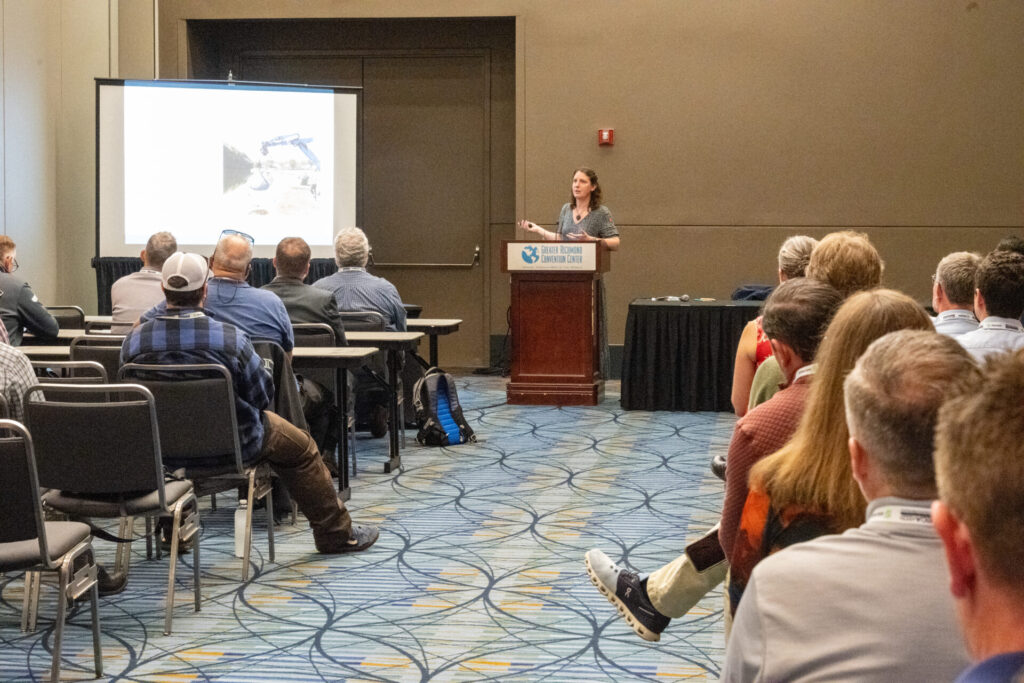Frog Environmental was delighted to present best practice at the International Erosion Control Association (IECA) Conference 2025, one of the world’s largest gatherings of environmental professionals.
This prestigious event, held in Spokane, Washington in late February, brought together global experts in erosion, sediment control, and stormwater management to share best practices, educate, and network.
Our Technical Director, Leela O’Dea, presented “Environmental protection techniques when working in water – case studies cited from across the UK.” Her talk highlighted the importance of environmental protection during engineering works in aquatic environments and outlined various techniques and Frog’s case studies from around the UK.

Leela’s presentation emphasised the need for effective planning, legal compliance, and innovative solutions to minimise environmental risks. The case studies provided practical examples of successful environmental protection measures including the use of the award-winning Bubble Curtains, demonstrating our commitment to sustainability and ecological preservation.
We are proud to have presented at this global event for a second year running and to have shared our expertise with fellow professionals dedicated to protecting our natural resources.
Presenting on environmental protection techniques when working in water
Frog Environmental was delighted to present best practice at the International Erosion Control Association (IECA) Conference 2025, one of the world’s largest gatherings of environmental professionals.
This prestigious IECA event, held in Spokane, Washington in late February, brought together global experts in erosion, sediment control, and stormwater management to share best practices, educate, and network.
Our Technical Director, Leela O’Dea, presented “Environmental protection techniques when working in water – case studies cited from across the UK.” Her talk highlighted the importance of environmental protection during engineering works in aquatic environments and outlined various techniques and Frog’s case studies from around the UK.
Why is environmental protection important?
Engineering works can damage habitats in rivers, lochs, reservoirs, and wetlands, affecting populations of invertebrates, plants, birds, and mammals.
These activities can also block the passage of migrating fish and damage spawning habitats during sensitive times. Protecting the environment ensures the sustainability of ecosystems and the economic resources they provide, whilst also ensuring your company is not fined under local regulations.
Legal requirements
Environmental regulatory bodies such as SEPA, EA, NRW, and NIEA require consents, licences, or permits for activities like sediment removal, bank protection, construction of bridges, and river diversions.
Even low-risk activities must adhere to environmental legislation to prevent pollution.

Environmental risks
Key environmental risks include silt pollution, oil pollution, debris control, and the spread of invasive species. Effective planning and monitoring are essential to mitigate these risks.
Techniques to minimise and mitigate environmental risks
- Silt pollution control
- Temporary water crossings: Prevent silt from entering water bodies during construction.
- Pumping and scour protection: Use Silt Mats(TM), Floc Mats(R) and bank protection measures to prevent erosion of channels.
- Isolation techniques: Employ bypass channels, cofferdams, and floating silt curtains to isolate work areas.
- Bubble Curtains
- Technology and specifications: Silt Bubble Barriers create barricades to control silt and oil spills. They also provide highly effective aeration and help with reducing underwater sound such as during construction and piling works.
- Considerations: Factors like flow rate, particle size, bathymetry, and installation specifics are crucial for effective bubble curtain deployment.
Case studies
Leela presented several case studies that illustrate successful environmental protection techniques:
Understanding and applying various environmental protection techniques is critical for controlling pollution and minimising ecological impact. Each site requires a tailored approach, and flexibility in project phases can be cost-effective.
Stay updated with Frog Environmental
We invite you to follow our LinkedIn page or subscribe to our quarterly newsletter for updates and news about our ongoing projects and innovations.
Frog Environmental are UK and European specialists in silt control and water quality, collaborating with contractors, regulators, and consultants across construction, utilities, marine, coastal, and public sectors.
We provide innovative, technical solutions to prevent ditch erosion with products developed in-house. With a focus on environmental protection, efficiency, and value, our expert team sets new industry standards.
Follow our news and updates, find out more about our products, or contact us for technical support.
